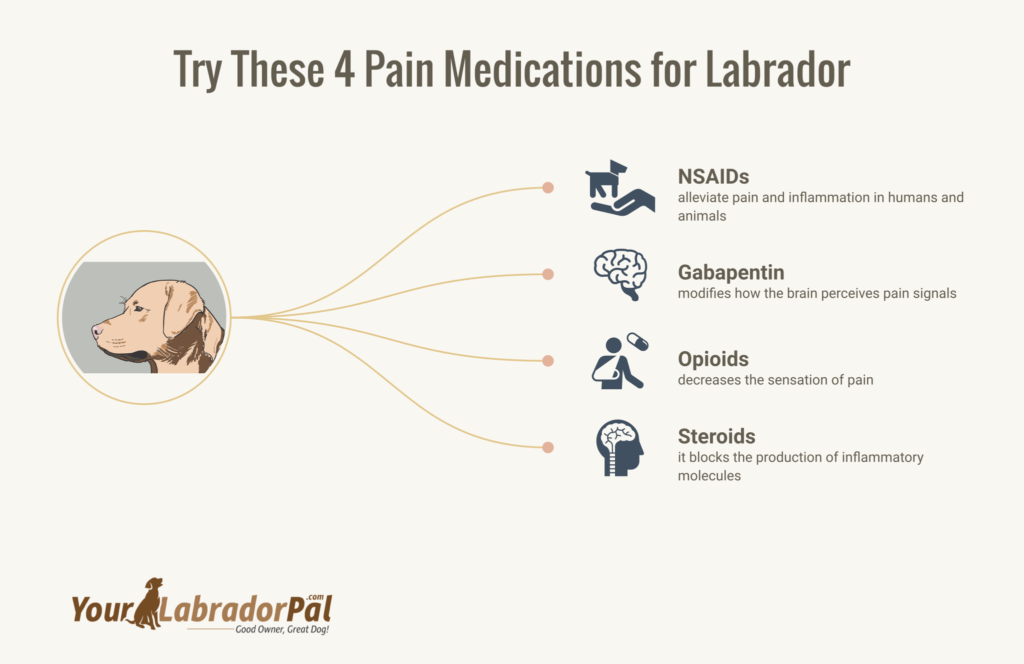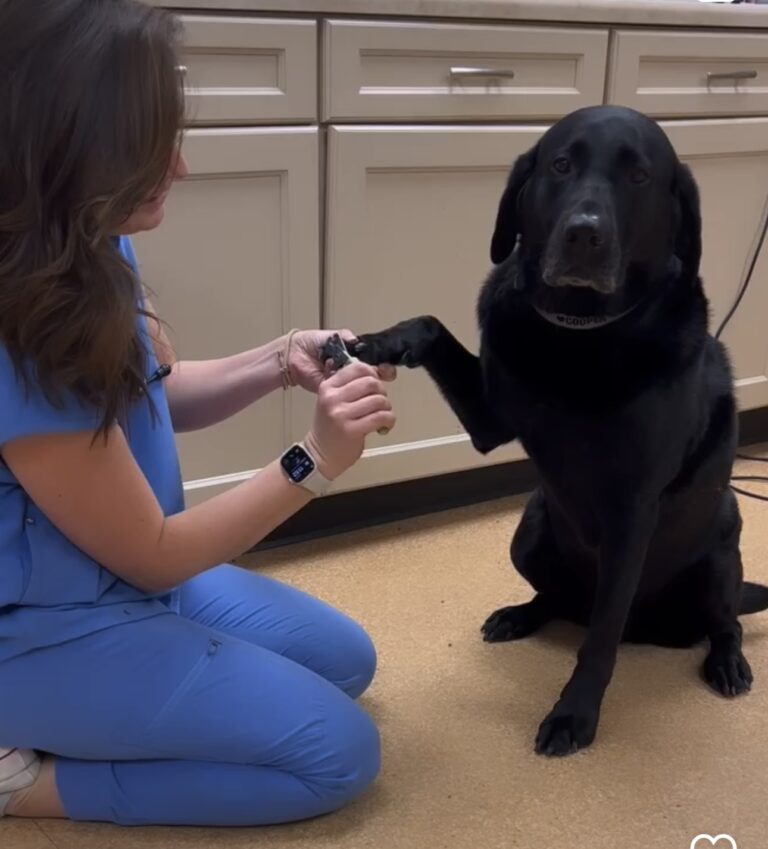What to Give Labrador for Pain? Pet Owner’s Pain Relief Options
Are you a Labrador Retriever owner who’s wondering “what to give Labrador for pain?” Seeing our pup whining, limping, or yelping in pain is heartbreaking. But knowing how to provide relief can be equally confusing. My first instinct is to ease his discomfort, whether it’s due to an injury or an underlying health condition. But I’m always trying to figure out what’s safe for him regarding medication.
So, what can I give my Labrador for pain? After extensive research and consulting with my vet, I’ve discovered some safe and effective options that have helped my pup manage his discomfort. Let’s dive into some solutions that’ll help our Labrador Retriever live a more comfortable life.
What Causes Pain in Labradors?
Unfortunately, like humans, our four-legged friends are not immune to pain and discomfort that can make them miserable and unable to enjoy their daily activities. As a dog parent, it is important to be aware of the common causes of pain in Labradors so that we can take appropriate measures to relieve them. Below are some of the common causes of pain in Labradors:
1: Arthritis
Labrador Retrievers are prone to developing arthritis, a degenerative joint disease that causes dog’s pain, inflammation, and stiffness in the joints. The condition can be caused by injury, obesity, genetic predisposition, or simply wear and tear due to aging. Some of the common signs of arthritis in dogs include limping, reluctance to move, stiffness in the joints, and difficulty in performing daily activities.
2: Hip Dysplasia
Hip dysplasia is a hereditary condition that affects a large number of Labrador Retrievers. The condition occurs when the hip joint is not formed properly, leading to abnormal movement and excessive wear and tear, which can cause severe pain, inflammation, and stiffness. The symptoms of hip dysplasia in Labradors include limping, bunny hopping, reluctance to move, and difficulty standing up or lying down.
3: Dental Problems
Dental problems such as gum disease, tooth decay, and oral tumors can cause pain and discomfort in dogs, including Labradors. These conditions can make it difficult for dogs to eat, drink, or play, leading to infections and other serious health problems if left untreated. Signs of dental problems in Labradors include bad breath, drooling, pawing at the mouth, and reluctance to eat or chew.
4: Cancer
Sadly, Labradors are also prone to developing cancer, which can be a major source of pain and discomfort for them. Common types of cancer affecting Labradors include lymphoma, osteosarcoma, and mast cell tumors. The symptoms of cancer in Labradors can vary depending on the type and location of the tumor but may include loss of appetite, weight loss, lethargy, and behavioral changes.
5: Surgical Procedures
Surgical procedures such as spaying, neutering, and dental extractions can also cause pain and discomfort in dogs, including Labradors. Dog owners must follow post-operative care instructions from their veterinarians to ensure a speedy recovery and minimize the risk of complications.
Early intervention can help to alleviate pain and improve the quality of life for our Labradors so that they can continue to enjoy the activities they love.
Signs That Your Labrador is in Pain
It can be difficult to tell when our beloved furry friends are in pain, as they cannot tell us directly. To ensure that your Labrador is comfortable and not suffering from pain or discomfort, it is essential to look out for the common signs of pain in dogs. These include:
❗Limping
If your Labrador is limping, it could indicate an injury or pain. This is especially true if they avoid weighing a specific leg. However, limping can also be a symptom of other health issues, such as arthritis or hip dysplasia, so it’s essential to get them checked by a veterinarian to determine the cause.
❗Yelping
If you notice your Labrador yelping or whimpering when it shouldn’t be, it could indicate that they’re in pain. For example, if they’re yelping when you touch them in a specific spot or when they move in a certain way, they’re likely experiencing discomfort.
❗Not Playing as Much
Labradors are generally active and love to play. If you notice that your dog isn’t as interested in playing as much as they used to be, it could be a sign that they’re not feeling their best. They may not be as willing to engage in activities that require physical exertion if they’re in pain or feeling unwell.
❗Sleeping More
If your Lab is sleeping more than usual, it could be because they’re experiencing pain or illness. Dogs often sleep more when not feeling well, just like humans do. If your dog sleeps excessively or seems lethargic, it’s worth speaking to your veterinarian.
❗Irritability
When labs are in pain, they may become more irritable or aggressive. It is because they may be feeling vulnerable and defensive. If your dog is exhibiting any signs of irritability, it’s important to watch them and ensure they’re not in pain or discomfort.
❗Lowered Tail
A lowered tail can be indicative of pain or discomfort. If your dog’s tail is usually held high and wagging but suddenly drops, it could be a sign that they’re not feeling well. Similarly, if they’re holding their tail close to their body or between their legs, it could indicate pain or discomfort.
❗Reluctance to Jump or Climb Stairs
If your dog hesitates to jump or climb stairs, it could be because they’re experiencing pain or discomfort. These actions require physical exertion, which can be difficult or painful for dogs in pain. If you notice a sudden reluctance to climb stairs or jump onto furniture, it’s worth getting them checked by a veterinarian.
❗Decreased Appetite
If your dog has a decreased appetite, it could indicate they’re not feeling well. Dogs in pain or experiencing illness may not feel like eating or find eating difficult due to discomfort.
Keeping an eye out for the signs that your dog may be in pain is essential for their overall health and well-being.
Can Labradors Safely Take Human Pain Medications?
While giving our dogs the same pain medication we take may be tempting, it’s essential to consider their unique physiology.
It’s important to note that human pain meds can be dangerous for dogs. Some types of medication can be toxic and cause liver, kidney failure, or heart problems. Aspirin, for example, can lead to gastrointestinal tract distress, ulcers, and anemia in dogs. Do not administer the most commonly used over-the-counter prescription medications for humans to your dog.
- Acetaminophen (Tylenol): Can cause liver and kidney damage
- Ibuprofen (Advil): Can cause ulceration and bleeding of the stomach, intestines, and kidneys
- Naproxen (Aleve): Can cause liver, kidney, heart, and central nervous system problems
Moreover, even when your vet prescribes, you should use human pain medication with caution. Dosages for dogs vary depending on age, weight, and health status. Giving your dog too much medication can cause serious harm, and you must ensure you are administering it correctly. Moreover, while we as humans are capable of following dosage instructions, dogs might accidentally consume the entire bottle of medicine if we leave it within their reach – which can be fatal. Always keep medication out of reach of your pets.
What to Give Labrador for Pain?
So what to give Labrador for pain? Ideally, you should consult your vet and follow their advice. In most cases, vets will prescribe the following:
NSAIDs
NSAIDs, which stands for Nonsteroidal Anti inflammatory Drugs, are a group of drugs commonly used to alleviate pain and inflammation in humans and animals. They work by inhibiting the production of prostaglandins, which are responsible for pain and inflammation in the body. Some common NSAIDs you may have heard of include aspirin, ibuprofen, and naproxen. While these medications can be beneficial for individuals, the same is not always true for dogs.
In veterinary medicine, these dog pain medications treat various conditions, such as arthritis, hip dysplasia, and post-surgical pain management. However, they can have side effects if used incorrectly or if the dosage is too high. Some side effects of NSAIDs in dogs include gastrointestinal distress, kidney problems, and liver damage. Therefore, you must talk to your veterinarian before administering these medications to your Labrador.
It’s important to note that certain types of anti-inflammatory drugs NSAIDs are safe for human consumption but can be lethal for dogs, even in small doses. Therefore, it’s crucial to consult your vet before giving your dog over-the-counter NSAIDs. Your veterinarian will recommend the right type of NSAID for your Labrador, depending on their size, weight, and medical condition. For example, carprofen is a commonly used NSAID in veterinary medicine as it is safe for dogs and has low toxicity.
Gabapentin
Gabapentin is an effective analgesic medication that modifies how the brain perceives pain signals. It is commonly prescribed to treat neuropathic pain, seizures, and anxiety disorders in humans, but it can also be given to dogs as a pain reliever. The body quickly assimilates Gabapentin, and its effects last up to eight hours, making it an ideal medication to help alleviate pain.
Labradors are prone to some health issues that can cause them significant pain. These include hip dysplasia, arthritis, and elbow dysplasia. Gabapentin can help reduce the pain and inflammation caused by these conditions, making it easier for your furry friend to move around and maintain a healthy lifestyle. It comes in various forms, such as capsules or liquid suspension, and it is essential to follow your veterinarian’s instructions when administering the medication.
Gabapentin is generally safe for dogs, but it has some possible side effects like any medication. These include drowsiness, dizziness, and incoordination. In some rare cases, Gabapentin can cause aggression or hyperactivity. Still, these side effects are rare, and if you notice any unusual behavior in your dog, you should contact your vet immediately. It is also essential to avoid abruptly stopping the medication, as this can lead to withdrawal symptoms such as anxiety and seizures. It is important to note that Gabapentin should never be given to dogs without a veterinarian’s approval.
Opioids
Opioids are a class of drugs that work by binding to the opioid receptors in the brain, spinal cord, and other parts of the body. This binding results in a decrease in the sensation of pain. Opioids also have a soothing effect, which can help manage the anxiety that some dogs may experience due to pain.
Some of the opioids that are commonly prescribed for dogs include tramadol, codeine, fentanyl, and oxycodone. The type and dose of opioid prescribed may vary depending on the severity of the pain and the dog’s size and medical condition. However, like any medication, opioids have potential side effects. The most common side effects of opioids in dogs include sedation, constipation, and vomiting. In some cases, opioids can worsen respiratory depression, especially if the dog has a pre-existing respiratory disease or is administered with too high a dose.
Opioids are usually given orally in the form of tablets or capsules. However, they can also be given by injection, either intravenously or subcutaneously, to achieve more immediate and potent pain relief for dogs. The veterinarian will provide precise instructions on administering the medication, including the frequency and duration of the treatment.
Steroids
Steroids, also known as corticosteroids, are synthetic drugs that mimic the effects of the hormone cortisol produced by the adrenal glands. Cortisol plays a significant role in the body’s physiological response to stress, inflammation, and injury. It regulates the immune system, reduces inflammation, and relieves pain. Steroids bind to specific receptors in the body, blocking the production of inflammatory molecules like prostaglandins and leukotrienes. This action reduces swelling, redness, and pain.
Steroids are highly effective in reducing pain in Labradors, particularly acute or sudden pain caused by injuries, inflammation, or post-surgical recovery. For example, if your Labrador has joint pain or swelling, steroids can reduce the inflammation and provide relief. Steroids can also be used for chronic conditions, such as arthritis, which cause long-term pain and discomfort. However, steroid use for chronic pain is often combined with other pain medications and should be monitored closely by a vet. It’s essential to note that steroids do not address the underlying cause of the pain but alleviate symptoms.
These are just a few pain medications that can be used in Labradors. It is essential to discuss your Labrador’s treatment plan with your vet and follow their instructions for administering medication. This way, you can ensure your furry friend stays happy and healthy.
Supplements and Natural Remedies to Ease Pain
Aside from pharmaceutical medications, several natural pain relief remedies and supplements can help your Labrador cope with pain and discomfort.
🌿CBD Oil
CBD (cannabidiol) oil is a natural extract derived from the hemp plant. It is known to have anti-inflammatory, analgesic, and anti-anxiety properties. CBD oil is not psychoactive, meaning it does not make your pet “high” or alter their behavior in any way.
CBD oil works by interacting with the endocannabinoid system (ECS), a regulatory system in the body that helps maintain balance and stability. The ECS system regulates various functions, such as pain sensation, appetite, immune function, and mood. CBD oil interacts with the CB1 and CB2 receptors in the ECS to reduce inflammation and pain.
When using CBD oil for your Labrador Retriever, choosing a high-quality, organic product is crucial. You can add CBD oil to their food and treats or give it to them directly using a dropper. The dosage may vary depending on their weight, age, and health condition. It’s best to start with a low dosage and gradually increase it until you find the right dose for your pet.
🌿Turmeric
Turmeric is a spice that’s derived from the Curcuma longa plant root of the ginger family. Turmeric, which has been used for centuries in Ayurvedic medicine, contains curcumin as its active ingredient. The compound has powerful anti-inflammatory properties that can aid in pain and swelling reduction in the body. As a result, it can be an ideal supplement for Labradors with joint pain and arthritis.
Turmeric is also an excellent natural remedy for digestive issues. It can help reduce inflammation in the gut, alleviating symptoms of irritable bowel syndrome, ulcers, and other gastrointestinal problems. Turmeric can also improve liver function, essential for detoxifying the body and processing nutrients. If your Lab has been experiencing digestive issues, adding turmeric to their diet could help improve their overall gastrointestinal health.
Turmeric can also serve as a natural source of pain relief. Instead of reaching for over-the-counter pain medications that can harm your Lab’s liver and kidneys, you can use turmeric as a safe and effective alternative. Turmeric can promote the production of endorphins, natural painkillers produced by the body. This can help reduce your Lab’s reliance on medication, making them more comfortable and less prone to side effects.
🌿Omega-3 Fatty Acids
Omega-3 fatty acids are a type of polyunsaturated fat that is essential to a dog’s health. They support the development and maintenance of body tissues and arachidonic acid metabolism. A notable property of Omega-3 fatty acids is that they reduce inflammation, which in turn reduces pain. Omega-3 fatty acids are found in fish oil, and most dog food does not contain sufficient amounts to be beneficial. While flaxseeds, chia seeds, and walnuts have Omega-3 fatty acids, dogs cannot fully digest the coat and hard shells that protect them from spoilage. Therefore, fish oil supplementation is a better option.
The dosage of Omega-3 Fatty Acids for your dog depends on their weight. It is recommended that at least 150 milligrams of EPA and DHA be administered per 10 pounds of body weight per day, with the dosage being adjusted every three months until you see a noticeable reduction in pain. It’s advisable to consult with your veterinarian to determine the appropriate dosage for your dog, as overdosing on Omega-3 can lead to stomach upset, gas, and diarrhea.
🌿Glucosamine
Glucosamine is a natural compound found in humans’ and dogs’ joints and cartilage. It is a supplement to help rebuild cartilage, reduce inflammation, and alleviate joint pain. This supplement helps to stimulate the body’s natural production of glycosaminoglycans and collagen, which are essential for healthy joints.
Labradors are at higher risk of joint problems due to size and weight. Their joints may weaken as they age, leading to conditions such as hip or elbow dysplasia, osteoarthritis, and other joint-related issues. Adding glucosamine to their diet can help reduce inflammation, relieve pain, and increase joint mobility. It can also help to maintain and repair cartilage damage and slow down the progression of joint diseases.
When choosing a glucosamine supplement for your Labrador, it is essential to consider the product’s quality and effectiveness. Look for supplements made from natural ingredients, with no fillers, artificial flavors, or preservatives. It is also important to consider the dosage recommendation, typically based on your dog’s weight.
🌿Chondroitin
Chondroitin sulfate is a compound that is found naturally in the cartilage of animals. It is a dietary supplement to promote healthy joints in dogs and humans. It works by reducing inflammation and enhancing cartilage production in the joints. Chondroitin is particularly effective in reducing pain and inflammation caused by arthritis as it blocks the enzymes that break down cartilage.
In addition to reducing pain and inflammation, chondroitin also helps to slow down the progression of arthritis. If taken regularly, it can reduce the severity of joint damage and prevent further deterioration. This is especially important for aging Labradors, who are more susceptible to joint problems than younger dogs.
Another crucial factor to keep in mind is that chondroitin should be used in conjunction with other treatments and lifestyle changes to ensure maximum effectiveness. These include regular exercise, a healthy diet, and weight management. Ensuring your Labrador Retriever maintains a healthy weight is key, as obesity puts additional strain on the joints.
These are just a few natural supplements that can help improve your Labrador Retriever’s joint health. It is important to remember that natural supplements should not replace conventional treatment but rather as an adjunct therapy to promote joint health and reduce inflammation. If you are considering any supplement for your Lab, it is best to consult your veterinarian first to ensure it is safe and appropriate for your dog.
Complementary Therapies
In addition to the natural supplements mentioned, other therapies can help support your Labrador Retriever’s joint health. My Labrador loves getting these complementary therapies, so I will share these with you so you can benefit from them too.
1: Photobiomodulation (cold laser therapy)
Photobiomodulation therapy is becoming more and more popular as a non-invasive, drug-free treatment on dog for pain relief. It involves using low-level laser light to stimulate cellular repair and reduce inflammation. You can use it to treat various dog conditions, such as arthritis, hip dysplasia, and back pain.
This therapy is completely pain-free for your Labrador Retriever and is usually done in a vet clinic. The procedure can last from a few minutes to half an hour, depending on the dog’s condition and response to the treatment. Some pet owners notice an improvement in their dog’s mobility and pain levels after only one treatment, while others may need a series of treatments for longer-lasting results.
2: Massage
Massage therapy is a gentle and non-invasive way to alleviate dog discomfort and muscle tension. It can help to increase circulation, reduce inflammation, and promote relaxation. This therapy can particularly benefit older dogs or those recovering from surgery or injury.
When massaging your Labrador Retriever, ensure that you are gentle and avoid painful areas. Focus on specific areas such as the neck, back, and hips, and use gentle kneading and circular motions. You can also use heating pads or warm towels to relax tight muscles before or after a massage.
3: Acupuncture
Acupuncture is an ancient Chinese therapy that involves the insertion of small needles into specific points on the body. It is becoming increasingly popular as a way to treat pain in dogs. It stimulates the nervous system, releasing natural painkillers such as endorphins.
While it may seem surprising to many pet owners, most dogs greatly tolerate acupuncture. It can take a few sessions for the full benefits of acupuncture to be noticed. It has a good track record of helping alleviate pain and improve mobility with other therapies.
4: Physical Therapy
Physical therapy is a broader term that encompasses any therapy that aims to improve mobility, function, and quality of life in dogs. This can include swimming, walking on a treadmill, and range of motion exercises. It can also include hydrotherapy (see below).
A licensed physical therapist can develop a tailored exercise program for your Labrador Retriever that addresses specific areas of concern. It can help them to maintain muscle mass, prevent muscle atrophy and alleviate pain.
5: Chiropractic Care
Chiropractic care is a complementary therapy that involves the manipulation of the spine. It can be incredibly effective at reducing pain and improving mobility in dogs. It involves gentle, precise movements to realign the spine and reduce inflammation.
Chiropractic care is a complementary therapy that a licensed practitioner should perform to ensure your dog receives the right care. Many pet owners have noticed a positive impact on the health of their dogs after a series of chiropractic adjustments.
6: Hydrotherapy
Hydrotherapy involves using water to treat pain and mobility issues in dogs. It can involve swimming or using an underwater treadmill. This therapy takes advantage of the properties of water, such as buoyancy and resistance, to help dogs move more freely and with less pain.
Hydrotherapy can be used to help your Labrador Retriever build endurance and strength, as well as improve mobility and joint range of motion. It is a great way to ease the effects of arthritis or hip dysplasia without putting too much strain on the joints.
So, there are many ways to support your Labrador Retriever’s joint health and reduce the effects of arthritis. While it is essential to consult your veterinarian before trying any of these therapies, many pet owners have found them incredibly beneficial for their dogs.
Frequently Asked Questions
Can I use cold or heat therapy to alleviate my Labrador’s pain?
Absolutely! When my own Labrador was experiencing some pain, I found that alternating between cold and heat therapy really helped to alleviate his discomfort. I used a cold compress on the affected area for about 20 minutes, then switched to a warm compress for another 20 minutes, and repeated this process a few times throughout the day. Of course, it’s essential to ensure not to use something too cold or hot and to watch out for any adverse reactions. One thing to keep in mind is that some of these compresses might smell bad, so you’ll want to be prepared for that. But overall, I’ve found this method to be a great natural way to help ease my pup’s pain.
Are there any specific dietary changes I should make to help manage my Labrador’s pain?
When my Labrador started experiencing chronic pain, I was at a loss for what to do. I spoke to our vet and did some research on my own, and one thing that kept popping up was the importance of proper nutrition. Making a few dietary changes could potentially help manage their pain and improve their overall health. One thing that I found helpful was increasing my Labrador’s intake of vegetables and lean proteins. It may not eliminate their pain, but it’s a step in the right direction toward a healthier canine companion.
What signs should I look for to determine if the pain medication is effective for my Labrador?
First of all, you should keep an eye on your pup’s energy levels. If they seem perkier and more alert than they were before, that’s a good sign. You should also look out for any changes in their mood – if they’re less irritable or restless, for example, that’s another positive indicator. Finally, you should pay attention to your pup’s behavior. Are they moving more easily or showing fewer signs of discomfort? If so, it’s a good sign that the medication works as it should.
Can I combine different pain medications for my Labrador?
While combining pain medications is a good idea, it’s not recommended unless specifically prescribed by a veterinarian. Mixing medications could lead to potential adverse reactions and even harm your pup. It’s much safer to consult with a vet and have them create a personalized treatment plan that considers your dog’s needs and health status. Remember, the goal is to help your Labrador feel better, not worse. So always prioritize their well-being over anything else.
Final Words
So, what to give Labrador for pain? After all the research and consultation I have done, I discovered several options for relieving their discomfort. Thus, if you have read this far, I am sure you can now make the right decision to help your Labrador Retriever with pain management. All the natural therapies and medications discussed in this article can benefit your pup’s health. Still, it is best to consult a qualified veterinarian before using them. Remember to keep track of your pet’s progress, and don’t forget to show them lots of love and attention!











